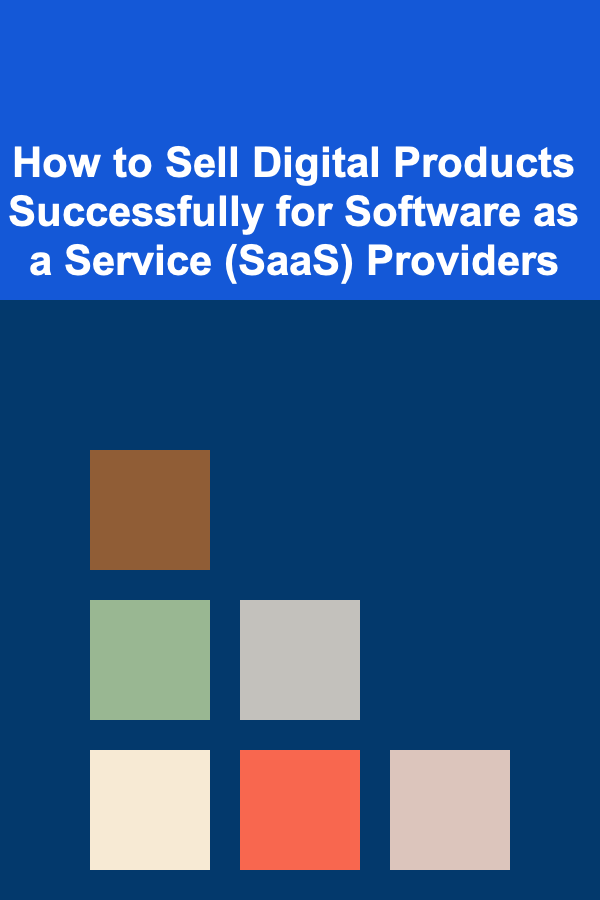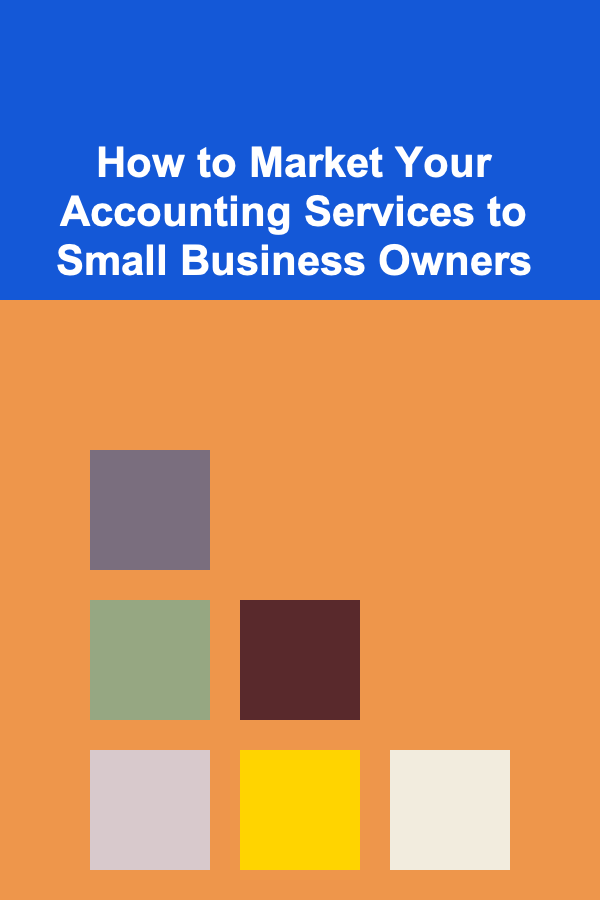
How to Sell Digital Products Successfully for Software as a Service (SaaS) Providers
ebook include PDF & Audio bundle (Micro Guide)
$12.99$11.99
Limited Time Offer! Order within the next:

Selling digital products, particularly in the Software as a Service (SaaS) space, is an exciting yet complex challenge. Unlike physical goods, SaaS products are intangible, but they offer a unique set of advantages for both the customer and the provider, such as scalability, recurring revenue, and global reach. However, in order to stand out in an increasingly crowded market, SaaS providers must adopt effective sales strategies that not only drive acquisition but also promote retention and long-term growth.
In this actionable guide, we'll explore the key steps to sell digital products successfully as a SaaS provider. From identifying your target market and creating an irresistible product to optimizing your sales and marketing efforts, this guide will provide you with the necessary insights to succeed in the competitive SaaS landscape.
Understand Your Market and Customer Pain Points
The foundation of a successful SaaS business lies in a deep understanding of your market and the problems your software solves. Without clear insight into the needs and challenges of your target audience, your product is unlikely to resonate with potential customers.
Define Your Target Audience
Identify your ideal customers by asking questions such as:
- Who will benefit the most from your product?
- What specific industry or niche does your software cater to?
- What are the pain points your product solves? (e.g., inefficiency, lack of automation, high costs, etc.)
Customer Personas
Once you've gathered data about your audience, create customer personas. These personas should include demographic data, job roles, typical challenges, and behaviors. The goal is to better understand what motivates your customers to make purchasing decisions.
Conduct Market Research
Before launching your product, conduct thorough market research. Analyze competitors, review customer feedback, and study industry trends. Tools like surveys, customer interviews, and online forums (e.g., Reddit, Quora) can offer invaluable insights into what your customers truly need and want.
Actionable Tip: Use tools like Google Analytics, surveys, and social listening to gather data on your audience. This will help refine your messaging and product features.
Create a High-Quality, Irresistible SaaS Product
A great SaaS product begins with understanding customer needs, but creating a high-quality product requires attention to detail and innovation. Your software must not only solve problems but also provide a seamless, enjoyable user experience.
Focus on User Experience (UX)
In the SaaS world, the product's usability is paramount. If customers find your software difficult to use or counterproductive, they will not stay long. Consider these elements:
- Simple onboarding: Guide users through the setup process with easy-to-follow tutorials or walkthroughs.
- Intuitive design: Ensure that your interface is clean and easy to navigate.
- Responsive performance: Optimize your software to be fast and reliable.
Regular Updates and Bug Fixes
Your SaaS product should evolve with the needs of your customers. Regular updates not only improve functionality but also show your commitment to providing value. Stay on top of bugs and ensure they're fixed as soon as they arise.
Actionable Tip: Create a roadmap for updates and new features based on customer feedback. Make your customers feel involved in the process by sharing the roadmap publicly and asking for suggestions.
Scalability and Flexibility
A good SaaS product grows with its customers. Ensure that your software can scale to meet increasing demand. For instance, if you're offering a cloud-based solution, ensure that your infrastructure can handle large amounts of data or users as your customer base expands.
Offer a Clear and Compelling Pricing Strategy
Pricing is one of the most important factors that affect a customer's decision to purchase a SaaS product. Getting your pricing right can significantly impact your revenue and conversion rates.
Choose the Right Pricing Model
There are several pricing models to choose from, each with its own advantages and challenges:
- Freemium: Offering a free version with limited features can attract customers and give them a taste of your product.
- Subscription-based: Monthly or annual subscription plans provide predictable revenue. Offering tiered pricing with different feature sets is a common approach.
- Pay-as-you-go: A pricing model based on usage (e.g., per transaction, per API call, etc.) can be attractive for customers who want flexibility.
Offer a Free Trial or Freemium Version
Many customers prefer to test a product before committing to a paid plan. Offering a free trial allows potential customers to experience the full functionality of your product without any initial commitment. Ensure that the trial period is long enough to demonstrate the value of your product but not so long that it delays the purchasing decision.
Alternatively, a freemium model offers limited functionality for free, with the option to upgrade to premium features. This helps to build an audience who may convert to paid users over time.
Transparent Pricing
Be clear and transparent with your pricing. Customers appreciate knowing exactly what they're paying for. Hidden fees or unclear pricing structures can be a turn-off and may lead to cart abandonment.
Actionable Tip: Analyze competitors' pricing to understand the going rate for similar products. Then, determine whether you want to position yourself as a premium product or a more affordable option.
Optimize Your Sales Funnel
To sell SaaS products successfully, you need an optimized sales funnel that leads potential customers from awareness to purchase with minimal friction. Every stage of the funnel should be well-designed to guide users seamlessly through the decision-making process.
Awareness Stage: Attract Traffic
Attracting potential customers starts with awareness. Content marketing, paid ads, and partnerships are great ways to generate traffic to your website.
- SEO: Optimize your website for search engines to increase organic traffic.
- Content marketing: Blog posts, ebooks, case studies, and whitepapers can educate your audience and build trust.
- Paid advertising: Use Google Ads, Facebook Ads, and LinkedIn Ads to target potential customers with specific interests.
Interest Stage: Nurture Leads
Once you've attracted traffic, the next step is to nurture leads and demonstrate the value of your SaaS product. Here are some strategies:
- Email marketing: Capture leads with email sign-ups and nurture them through a sequence of educational and persuasive emails.
- Webinars and demos: Provide potential customers with live or recorded demos that show how your product works and the problems it solves.
Decision Stage: Drive Conversions
When leads are on the verge of making a decision, you need to ensure that the process is as seamless as possible. Offering limited-time promotions or highlighting your product's unique selling points (USPs) can help close the deal.
- Clear call-to-action (CTA): Your website and emails should have compelling CTAs that encourage users to start a trial or purchase.
- Testimonials and reviews: Social proof can influence customers at the final stage of their decision-making process. Display positive reviews or case studies that show how your software has helped others.
Actionable Tip: Continuously test and optimize your sales funnel. Use A/B testing to determine which messaging, CTAs, and content formats yield the best results.
Focus on Customer Success and Retention
Selling a SaaS product doesn't end after the initial sale. Retaining customers is crucial for long-term success. The goal is to ensure that customers not only continue paying for your product but also become loyal advocates for your brand.
Provide Exceptional Customer Support
Offer multiple channels for customer support (e.g., live chat, email, knowledge base). A fast, helpful, and friendly support team can resolve issues quickly, preventing churn and building goodwill.
Onboarding and Education
The onboarding process plays a crucial role in customer retention. Make it easy for new users to understand how to use your product effectively. Consider creating video tutorials, guides, and interactive walkthroughs to help users get started.
Monitor Usage and Engagement
Track how your customers use your software to identify potential issues and opportunities for improvement. If users are not engaging with key features, consider reaching out with educational content to encourage deeper product usage.
Actionable Tip: Implement a customer success program that focuses on helping your customers achieve their goals with your product. Regular check-ins and feedback loops will allow you to continuously improve and enhance the customer experience.
Build a Strong Brand and Community
A strong brand and a loyal community can be powerful drivers of success in the SaaS space. Building a brand involves more than just having a great product; it's about creating a company that customers believe in and feel connected to.
Engage with Your Audience
Foster community engagement through social media, webinars, and user groups. Actively listen to feedback and make your customers feel heard. By engaging with your audience, you not only gain valuable insights but also build trust.
Brand Advocacy
Encourage satisfied customers to share their experiences and become advocates for your product. Offer incentives for referrals, such as discounts or additional features.
Actionable Tip: Develop a content strategy that shares your company's mission, values, and vision. Align your messaging with what matters most to your customers, and always focus on delivering value.
Conclusion
Selling digital products as a SaaS provider requires a comprehensive approach that includes understanding your audience, offering a high-quality product, optimizing your sales funnel, and focusing on customer retention. By taking the time to research, iterate, and build strong relationships with your customers, you'll be well-positioned to succeed in the highly competitive SaaS market.
Remember, success doesn't happen overnight, but by consistently delivering value and adapting to the changing needs of your customers, you can build a thriving SaaS business that stands the test of time.

How to Build Wealth Using Dividend Stocks
Read More
How to Clean and Maintain Your Home's Baseboards and Trim
Read More
How to Market Your Accounting Services to Small Business Owners
Read More
How to Market Your Automotive and DIY Products with Influencers: An Actionable Guide
Read More
How to Store Essential Oils Safely and Effectively
Read More
How to Use Labels Effectively for Meal Prep Containers
Read MoreOther Products

How to Build Wealth Using Dividend Stocks
Read More
How to Clean and Maintain Your Home's Baseboards and Trim
Read More
How to Market Your Accounting Services to Small Business Owners
Read More
How to Market Your Automotive and DIY Products with Influencers: An Actionable Guide
Read More
How to Store Essential Oils Safely and Effectively
Read More